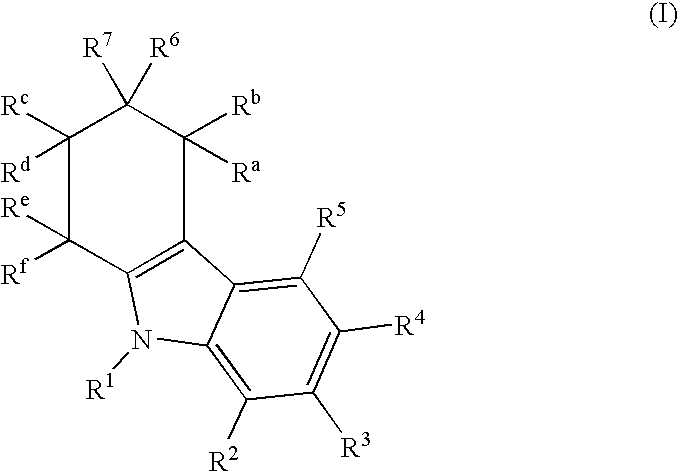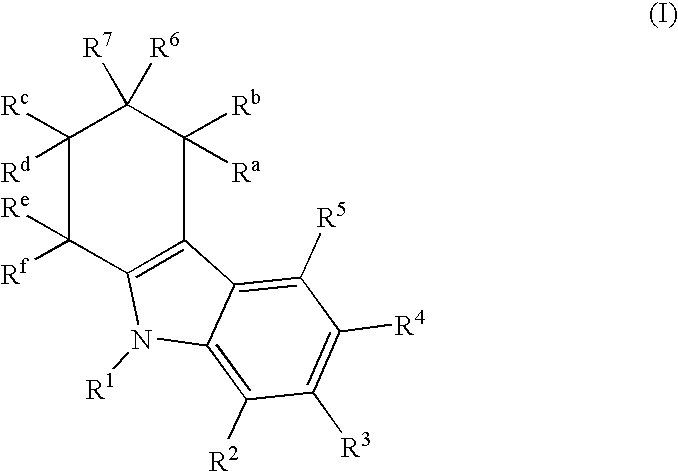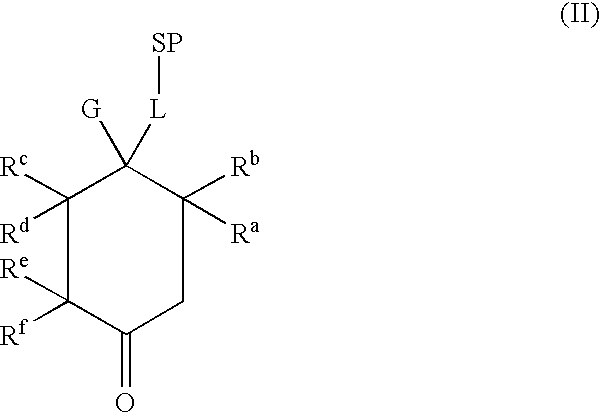Tetrahydrocarbazol derivatives as ligands for G-protein-coupled receptors (GPCR)
a technology of gprotein and carbazol derivatives, which is applied in the direction of peptides, drug compositions, peptides, etc., can solve the problems of low bioavailability and metabolic instability, increased gonadotropin and sex steroid release, and unsuitable for male birth control
- Summary
- Abstract
- Description
- Claims
- Application Information
AI Technical Summary
Benefits of technology
Problems solved by technology
Method used
Image
Examples
examples
I. General Synthesis Instructions for Compounds According to the Invention
A. Coupling of Carboxylic Acids to the Rink Amide Resin:
[0168]0.1 mmol of Fmoc-protected Rink amide resin (166 mg, concentration 0.6 mmol / g) is presteeped in a vessel with a fritted bottom with 1.5 ml of DMF for 20 minutes. After being suctioned off, 1.5 ml of 20% piperidine / DMF is added, and it is stirred for 5 minutes. After being suctioned off, 1.5 ml of 20% piperidine / DMF is added again and stirred for 15 minutes. After being suctioned off, it is washed four times with DMF. Then, 675 μl of a 0.267 M solution of Fmoc-protected amino-carboxylic acid in DMF, 675 μl of HATU solution (0.267 M in DMF) and 150 μl of NMM solution (2.4 M in DMF) as well as 0.01 mmol of DMAP are added and stirred for 4 hours at 40° C. After being suctioned off, the same reagents are added again and stirred for 4 hours at 40° C. Then, it is suctioned off and washed four times with DMF.
B. Coupling of Carboxylic Acids to the Trityl Res...
example i
[0217]0.3 mmol (42.6 mg) of 4-oxocyclohexanecarboxylic acid is dissolved in 1 ml of acetic acid and added to a suspension of 0.3 mmol (43.3 mg) of phenylhydrazine hydrochloride and 0.3 mmol (40.0 mg) of ZnCl3 in 1 ml of acetic acid. After 20 hours of stirring at 70° C., it is diluted with 20 ml of water and extracted with ethyl acetate. The ethyl acetate phase is washed with water, dried on Na2SO4 and evaporated to the dry state. Yield: 65.6 mg (100%) of white solid.
[0218]
NameNumberMgefMcalc2,3,4,9-Tetrahydro-1H-carbazole-3-8215215.2507carboxylic acid
[0219]The column headings that are used here also apply to the examples below (Name, Number of the compound, Mgef (determined molecular mass), Mcalc (calculated molecular mass)), which therefore are no longer repeated.
example 2
[0220]The synthesis is carried out on a 0.2 mmol scale according to instructions A, I and O.
[0221]
2,3,4,9-Tetrahydro-1H-carbazole-3-9214214.2666carboxylic acid amide
PUM
| Property | Measurement | Unit |
|---|---|---|
| body weight | aaaaa | aaaaa |
| body weight | aaaaa | aaaaa |
| weight | aaaaa | aaaaa |
Abstract
Description
Claims
Application Information
 Login to View More
Login to View More - R&D
- Intellectual Property
- Life Sciences
- Materials
- Tech Scout
- Unparalleled Data Quality
- Higher Quality Content
- 60% Fewer Hallucinations
Browse by: Latest US Patents, China's latest patents, Technical Efficacy Thesaurus, Application Domain, Technology Topic, Popular Technical Reports.
© 2025 PatSnap. All rights reserved.Legal|Privacy policy|Modern Slavery Act Transparency Statement|Sitemap|About US| Contact US: help@patsnap.com



